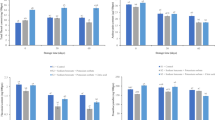Abstract
A field experiment and two oxidation experiments in the laboratory were carried out. The content of the major anthocyanins, cyanidin-3-glucoside (Cy-3-G) and cyanidin-3-sambubioside (Cy-3-Sa), in the fresh fruits from the 13 cultivars were from 361 to 1266 and from 269 to 656 mg/100 g, respectively. The two minor anthocyanins, cyanidin-3-sambu-bioside-5-glucoside (Cy-3-Sa-5-G) and cyanidin-3,5-diglucoside (Cy-3.5-dG), occurred in concentrations between 5 and 47 mg/100 g. The content of ascorbic acid and quercetin in the fresh fruits of the cultivars varied from 6 to 25, and from 29 to 60 mg/100 g, respectively. Purging of the elderberry juice with N2 and/or addition of ascorbic acid reduced the oxidative degradation rate of the two major anthocyanins and quercetin. Ascorbic acid protected the anthocyanins, but not quercetin from oxidative degradation. Mixing of fruits with air during processing and even a low content of oxygen in the juice before tapping must be avoided by appropriate steps during processing. Improvement of the nutritional value of the elderberry juice and increased protection of anthocyanins against oxidative degradation may potentially be obtained by selection of cultivars with a high content of ascorbic acid.
Similar content being viewed by others
References
Porpárczy A, Laszlo M (1984) Evaluation of elderberry (Sambucus nigra L.) clones based on the quality of the fruit. Acta Alimen 13: 109–115.
Buchman D (1980) Herbal Medicine. The Natural Way to Get Well and Stay Well. New York: Gramercy Publishing Co.
Kaack, K (1996) ‘sampo’ and ‘samdal’. Elderberry cultivars for juice concentrates. Fruit Variety J 51: 28–31.
Crozier A, Lean MEJ, McDonald MS, Black C (1997) Qualitative analysis of the flavonoid content of commercial tomatoes, onions, lettuce, and celery. J Agric Food Chem 45: 590–595.
Harborne JB, ed (1994) The Flavonoids. Advances in Research Since 1986. London: Chapman and Hall.
Serkedjieva J, Manolova N, Zgórniak-Nowosielska I, Zawili'nska B, Grzybek J (1990) Antiviral activity of the infusion (SHS-174) from flowers of Sambucus Nigra, aerial parts of Hypericum perforatum L., and roots of Saponaria officinalis L. Against influenza and herpes simplex viruses. Phytoterapy Res 4: 97–100.
Stavric B, Matula TT (1992) Lipid soluble antioxidants. In: Augustine S, Packer L (eds) Flavonoids in Foods, pp. 274–294.
Wattenberg LW (1985) Chemoprevention of cancer. Cancer Res 45: 1–8.
Wattenberg LW (1990) Inhibition of carcinogenesis by minor nutrient constituents of the diet. Proc Nutr Soc 49: 173–183.
Starr MS, Francis FJ (1968) Effect of ascorbic acid on the relative stability of four anthocyan pigments in cranberry juice. Food Technol 22: 1293.
De Whalley CV, Rankin SM, Hoult JRS, Jessup W, Leake DS (1990) Flavonoids inhibit the oxidative modification of low density lipoproteins by macrophages. Biochem Pharmacol 39: 1743–1750.
Citores L, de Benito FM, Iglesias R, Ferreras JM, Jimenez P, Argueso P, Faarias G, Mendez E, Girbes T (1996) Isolation and characterization of a new non toxic two chain ribosome inactivating protein from fruits of elder (Sambucus nigra L.). J Exp Bot 47:1577–1585.
Brandt K, Kondo T, Aoki T, Goto T (1993) Structure and biosynthesis of anthocyanins in flowers of Campanula. Phytochemistry 33: 209–212.
Brønnum-Hansen K, Flink JM (1983) High performance liquid chromatographic separation of anthocyan of Sambucus Nigra. J Chromatogr 262: 385–392.
Kaack, K. 1988. Semi-quantitative spectrophotometric determination of fruit juice adulteration by anthocyanin analysis. Tidsskr Planteavl 92: 279–287.
Lento HG, Daugherty CE, Denton AE (1969) Ascorbic acid measurement. Polarographic determination of total ascorbic acid in foods. J Agric Food Chem 11: 22–26.
Groven I (1968) Experiments with large fruited elderberry cultivars. Report 844. Danish Institute of Agricultural Science.
Fischer R, Gloris K, Seibt G (1972) Beitrag zur Kenntnis der Qualität der Holunderbeermuttersäfte des Handels. Flüss Obst 39: 249–254.
Clegg KM, Morton AD (1968) The phenolic compounds of black currant juice and their protective effect on ascorbic acid, II: The stability of ascorbic acid in model systems containing some of the phenolic compounds associated with black currant juice. J Food Technol 3: 277–284.
Harper KA (1969) Copper flavonoid complex in acidic solutions. J Food Technol 4:405–407.
Shrikhande AJ, Francis FJ (1974) Effect of flavonols on ascorbic acid and anthocyanin stability in model systems. J Food Sci 39: 904–906.
Sondheimer E, Kertesz ZI (1953) Participation of ascorbic acid in the destruction of anthocyanins in strawberry juice and model systems. Food Res 18: 475.
Wei H, Tye L, Bresnick E, Birt DF (1990) Inhibitory effect of apigenin, a plant flavonoid, on epidermal ornithine decarboxylase and skin tumor promotion in mice. Cancer Res 50:499–502.
Author information
Authors and Affiliations
Rights and permissions
About this article
Cite this article
Kaack, K., Austed, T. Interaction of vitamin C and flavonoids in elderberry (Sambucus nigra L.) during juice processing. Plant Foods Hum Nutr 52, 187–198 (1998). https://doi.org/10.1023/A:1008069422202
Issue Date:
DOI: https://doi.org/10.1023/A:1008069422202




